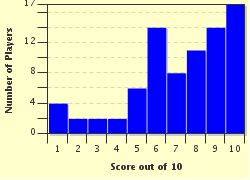Quiz Answer Key and Fun Facts
1. The short story "Just Before the War with the Eskimos" begins with two girls, Selena and Ginnie, finishing their tennis match and arguing over who will pay the taxi fare home. In a novel by the same author, the protagonist once played tennis with his teacher Mr. Antolini, before being expelled from Pencey Prep.
Which American author and famous recluse wrote those two tennis-inspired works?
2. One character serves, the other one returns. Games are played to four points, alternating serves, and various mistakes can lose you a point. It's not tennis, but it sure sounds like it: This actually describes the Questions game, which is played by the two title characters in a Tom Stoppard play. Which two men, who also appear in a much more famous play by Shakespeare, are enthusiasts of Stoppard's Questions game?
3. In a climactic scene, Lucy Honeychurch breaks off her engagement to Cecil Vyse for what appears to be a remarkably inane reason: he won't play tennis! Of course, the real reason is that Lucy is actually in love with George Emerson, and they elope to Florence at the end of the novel in which they appear.
Which novel is that, exactly?
4. Using secret messages passed through tennis balls, smuggled in during normal matches, allows the Duc de Beaufort to escape from the imprisonment imposed by Cardinal Mazarin. Mazarin's two loyal agents, Porthos and d'Artagnan, pursue Beaufort, before they are reunited with two other companions.
Those events occur in "Twenty Years After", the second novel in a famous series written by which French author?
5. Klipspringer is clearly late for a tennis match, because he makes an urgent call to a mansion in West Egg asking for his tennis shoes. Unbeknownst to him, the owner of said mansion had been shot in his swimming pool by George Wilson, and Nick Carraway picks up the telephone. In which American classic do those events occur?
6. In a certain play, the French dauphin clearly doesn't think much of his English adversary: in fact, to mock the king's youth, he sends over a case of tennis balls across the English Channel. Historically accurate? Perhaps not, but that never stopped anyone! In which Shakespeare play is the English king so enraged by the "gift" that he invades France, delivers a speech on St. Crispin's Day, and wins the Battle of Agincourt?
7. None of Carol Kennicott's plans seem to go right: Gopher Prairie's stage production of "Androcles and the Lion" is an abject failure, and a planned tennis tournament goes awry when only she and Erik Lovborg show up to play. In which novel satirizing small-town America, which was written by the first American Nobel Laureate in literature, does that tennis match fail to really work out?
8. The short story "The Facts of Life" depicts the successes of tennis player Nicky Garnet, both on and off the court, rather to his father's distaste. That story, however, pales in comparison to works like "The Razor's Edge" and "Of Human Bondage". Which British author was responsible for the short story and those novels?
9. One postmodernist author of note wrote an essay entitled "Federer as Religious Experience," which should be reason enough to suspect him of tennis bias. However, that author's best-known novel was informed by his own youth, spent playing in tennis tournaments, and is even partially set at the Enfield Tennis Academy. Who is this modern author of the gargantuan and complex novel "Infinite Jest"?
10. Martin Amis once wrote that "Nabokov was the more 'complete' player. Joyce seemed to be cruising about on all surfaces at once, and maddeningly indulged his trick shots on high-pressure points--his drop smash, his sidespun half-volley lob. Nabokov just went out there and did the business, all litheness, power and touch."
Vladimir Nabokov wasn't just a good writer; he was a good tennis player too, so it stands to reason that he'd be a good writer about tennis. In which novel did he describe the "teasing delirious feeling of teetering on the very brink of unearthly order and splendor" caused by the title girl's tennis game?
Source: Author
adams627
This quiz was reviewed by FunTrivia editor
looney_tunes before going online.
Any errors found in FunTrivia content are routinely corrected through our feedback system.

